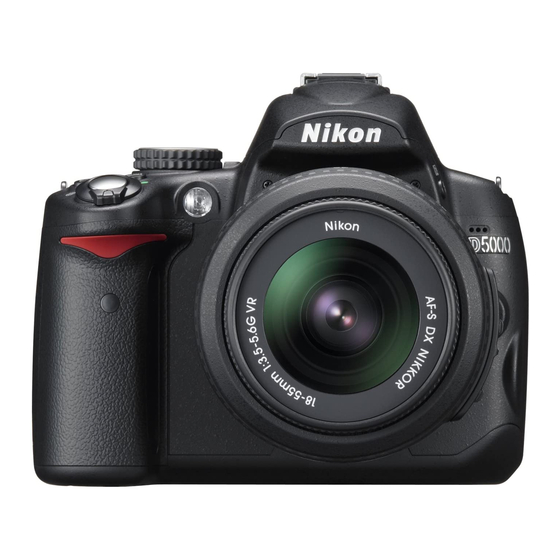Nikon D5000 Manual - Página 26
Navegue en línea o descargue pdf Manual para Objetivo de la cámara Nikon D5000. Nikon D5000 32 páginas. Nikon digital slr camera product brochure
También para Nikon D5000: Folleto (9 páginas), Hoja de trucos (2 páginas), Manual de reparación (20 páginas)

6. SET THE CORRECT WHITE BALANCE
Color balance correction is the process of rendering accurate colors in your fi nal
image. Most people don't even notice that light has different color characteristics
because the human eye automatically adjusts to different color temperatures, so
quickly, in fact, that everything looks correct in a matter of milliseconds.
When color fi lm ruled the world, photographers would select which fi lm to use
depending on what their light source was going to be. The most common fi lm was
balanced for daylight, but you could also buy fi lm that was color balanced for tung-
sten light sources. Most other lighting situations had to be handled by using color
fi lters over the lens. This process was necessary for the photographer's fi nal image to
show the correct color balance of a scene.
Your camera has the ability to perform this same process automatically, but you can
also choose to override it and set it manually. Guess which method we are going to
use? You are catching on fast! Once again, your photography should be all about
maintaining control over everything that infl uences your fi nal image.
Luckily, you don't need to have a deep understanding of color temperatures to con-
trol your camera's white balance. The choices are given to you in terms that are easy
to relate to and that will make things pretty simple. Your white balance choices are:
• Auto: The default setting for your camera. It is also the setting used by all of the
automatic scene modes (see Chapter 3).
• Daylight: Most often used for general daylight/sun-lit shooting.
• Shade: Used when working in shaded areas that are still using sunlight as the
dominant light source.
• Cloudy: The choice for overcast or very cloudy days. This and the Shade setting
will eliminate the blue color cast from your images.
• Tungsten: Used for any occasion where you are using regular household-type
bulbs for your light source. Tungsten is a very warm light source and will result in
a yellow/orange cast if you don't correct for it.
• Fluorescent: Used to get rid of the green-blue cast that can result from using
regular fl uorescent lights as your dominant light source. Some fl uorescent lights
are actually balanced for daylight, which would allow you to use the Daylight
white balance setting.
• Flash: Used whenever you're using the built-in fl ash or using a fl ash on the hot
shoe. You should select this white balance to adjust for the slightly cooler light
that comes from using a fl ash. (The hot shoe is the small bracket located on the
C H A P T E R 1 : T H E D 5 0 0 0 T O P T E N L I S T
13
